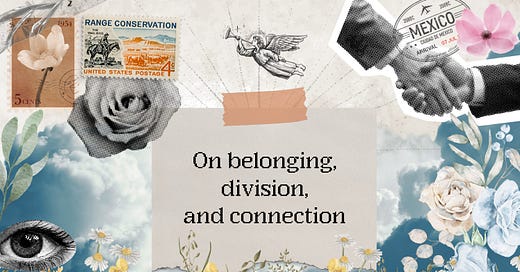I am a border child, shaped by two nations, two cultures, and a history of movement. How do I even begin to unpack the complexity of a bi-national identity?
Allow me to share a story. The house where my grandparents lived in the ’60s in Mexicali, Baja California, was less than half a mile from the California border. It was the same house where my mother, aunts, and uncles grew up. The same house where I spent the first four years of my life.
Heartbreakingly, I never had the blessing of meeting my grandmother, though I feel deeply connected to her through the stories my family carries on. She was an avid reader, laid-back, brilliant, tender, and caring. A safe space for those around her, she was the one people turned to for solace.
She was also a hardworking Mexicana. Born in Jalisco, she left her home as a teenager, traveling north in search of new frontiers, quite literally.
The bravery of my grandmother and her siblings, moving cross-country in search of new horizons, is a testament to the adventurous spirit that runs in my veins. I take a deep breath as I come to this realization, honoring the strength in my ancestry.
But this story is about more than just my family. It’s about how love, work, and history can cross borders. It’s said that my grandmother used to walk from her home in Mexico to her job in the U.S. – a daily journey across an almost invisible border. A simple chain once marked the separation between two nations. People passed freely, their lives intertwined.
That freedom ended in the 1990s, when the simple chain was replaced with a towering barrier of metal scraps repurposed to divide what was once fluid. Where neighbors once exchanged greetings over a simple chain, now there stood a wall, silent and imposing.
On the US side, there was a mural painted– a 2-mile long mural that serves as a homage to the camaraderie that used to exist between the border towns. Designed by artist Amando Rascon, the mural was Olmec-inspired, woven together like a friendship bracelet. Once a symbol of unity, then a quiet reminder of what was lost. How powerful is that? It doesn’t just paint a picture, it’s a scar on the landscape, a visible wound where friendships, families, and lives were once intertwined.
Rethinking borders—both real and imagined—and envisioning spaces where we coexist as humans is at the heart of my work. My visionary nature, my pursuit of daydreaming, is a gateway to liberation.
I like to imagine what it must have been like to live in kinder times– to walk freely, without the looming fear that your immigration status could determine your safety and well-being. And yet, in today’s challenging landscape for the Latinx community in the U.S., I firmly believe that stories have the power to heal. This is why I decided to share this personal story with you. I embrace my origins and honor where I come from. In a world that encourages us to accept labels, I choose to remain free. I will always be ni de aquí, ni de allá (neither from here, nor from there). But maybe that’s where the beauty lies, not in belonging to one place, but in carrying both within me.
May this story remind us that borders are lines on a map, not walls between hearts. May we heal in community, and may the world unlearn the illusion that human belonging can ever be made legal or illegal.
Until next time,
Irlanda








Que padre!
Amazing and beautifully written, thank you for sharing! ✌🏼